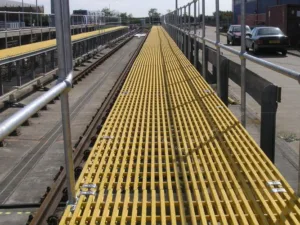Introduction
When it comes to choosing the right material for flooring applications, especially in industrial and commercial settings, there are several options available in the market. Fiberglass floor grating and various other materials, such as steel, aluminum, and wood, are commonly used. However, the cost-effectiveness of each option plays a crucial role in the decision-making process. In this article, Unicomposite composite profiles will explore and compare the prices of fiberglass floor grating with those of other materials to determine which one offers the most value for money.

fiberglass floor grating price
1. Understanding Fiberglass Floor Grating
1.1 What is Fiberglass Floor Grating?
Fiberglass floor grating is a type of composite material made from glass fibers and a resin matrix. It is renowned for its exceptional strength, durability, and resistance to corrosion, making it ideal for various industrial and commercial applications.
1.2 Advantages of Fiberglass Floor Grating
- Lightweight and easy to handle.
- Non-conductive, providing safety in electrical environments.
- Low maintenance requirements.
- High resistance to chemicals and harsh environments.
- Slip-resistant surface for added safety.
2. Other Flooring Materials
2.1 Steel Flooring
Steel flooring is a popular choice for heavy-duty applications due to its robustness and load-bearing capacity. However, it has some drawbacks, such as susceptibility to corrosion and higher maintenance needs compared to fiberglass.
2.2 Aluminum Flooring
Aluminum flooring is known for its lightweight and corrosion-resistant properties. It is commonly used in marine environments and areas where weight is a concern. Nevertheless, it may not be as durable as fiberglass in certain harsh conditions.
2.3 Wood Flooring
Wood flooring has been used for centuries and can bring a warm and classic look to spaces. However, it is not suitable for industrial settings due to its limited load capacity and vulnerability to rot and decay.
3. Fiberglass Floor Grating Price vs. Other Materials
3.1 Initial Cost Comparison
Fiberglass floor grating tends to have a slightly higher initial cost compared to wood flooring but is generally more cost-effective than steel and aluminum flooring options. While the upfront investment may be higher, the long-term benefits outweigh the initial expense.
3.2 Maintenance Costs
When evaluating the cost-effectiveness of flooring materials, it is essential to consider maintenance expenses. Fiberglass grating requires minimal maintenance over its lifespan, significantly reducing ongoing costs compared to steel and aluminum, which need regular inspections and treatments to prevent corrosion.
3.3 Replacement and Durability
Fiberglass floor grating’s high durability ensures a longer service life compared to wood, steel, or aluminum. The need for frequent replacements can significantly impact the overall cost of flooring. In this aspect, fiberglass proves to be more cost-effective.
4. Choosing the Right Flooring Material
To make an informed decision, consider the following factors:
4.1 Application
Evaluate the specific requirements of your project or application to determine which material best suits your needs. Consider factors like load-bearing capacity, chemical resistance, and environmental conditions.
4.2 Budget and Long-Term Investment
While the initial cost is important, remember that a slightly higher investment in fiberglass floor grating can result in significant long-term savings due to reduced maintenance and replacement expenses.
4.3 Safety Considerations
Fiberglass grating offers superior slip resistance, making it an excellent choice for areas prone to spills or wet conditions. Prioritize safety when choosing a flooring material.
Conclusion
In conclusion, fiberglass floor grating stands out as a cost-effective option when compared to other flooring materials like steel, aluminum, and wood. Its high durability, low maintenance needs, and excellent chemical resistance make it an ideal choice for various industrial and commercial applications. While the initial investment may be slightly higher, the long-term savings and safety benefits it provides outweigh the cost difference.
FAQs
- Is fiberglass floor grating suitable for outdoor applications?
- Yes, fiberglass floor grating is well-suited for outdoor use due to its excellent resistance to weather conditions.
- Can fiberglass grating be customized to specific requirements?
- Absolutely! Fiberglass grating can be tailor-made to meet the exact specifications of your project.
- Are there any color options available for fiberglass grating?
- Yes, fiberglass grating comes in a variety of colors to match different aesthetics and safety requirements.
- What is the typical lifespan of fiberglass floor grating?
- With proper installation and maintenance, fiberglass floor grating can last up to 20-30 years or more.
- Can fiberglass grating withstand heavy loads?
- Yes, fiberglass grating has an impressive load-bearing capacity, making it suitable for heavy-duty applications.




























